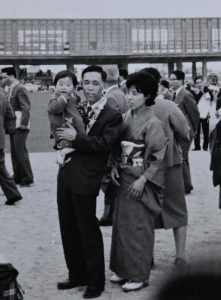My Life — Interview with Hiromu Morishita (1930–), A-bomb survivor and teacher, Part 9: Birth of first daughter
Apr. 30, 2022
Pushed him toward peace activities
In 1961, Hiromu Morishita married his wife, Hisako, now 87.
After I became a full-time teacher, there were several conversations about an arranged marriage. However, there was a case in which, before I met the prospective bride, an older brother appraised me and turned down the proposal after seeing my face. My wife, Hisako, coincidentally had an older brother who experienced the atomic bombing near the west end of Tsurumibashi Bridge, in Hiroshima’s Naka Ward, where he had been mobilized to work for the war effort and suffered burns to his face similar to mine. At that point, I felt a sense of relief since I didn’t have to worry about my face. Hisako and I also had something in common in that we both practiced calligraphy. Our wedding ceremony was held at a church in the city, and we held a small reception at a caterer.
Their first daughter was born in January 1963.
It was snowing heavily that day. That’s why we named her Chiyuki. While I was waiting in a separate room in the maternity clinic warming myself over a charcoal brazier, I worried whether there might be some kind of effect from the atomic bombing on my daughter. After she was born, though, the first thing my wife said was, “Great news! There’s nothing wrong with her.” I was so relieved.
Even with her eyes as yet unopened, my daughter clung to her mother’s breast. I was moved by that scene. I marveled at the strong life force. It felt like my daughter clapped my previously hesitant self on the back. When I gazed at my daughter’s face as she slept peacefully, images of infants charred black in the atomic bombing would suddenly intrude. It was at that moment I felt strongly that “the tragedy must never be repeated.”
The students I was teaching around that time were a generation that had not experienced the atomic bombings. I began to feel that I should share my experience with them as someone who was in contact with them.
Pushed by that feeling, he participated in the selection committee for the [1964] Hiroshima-Nagasaki World Peace Pilgrimage proposed by the American peace activist Barbara Reynolds.
I was delighted to receive a telegram informing me of my selection as a participant in the peace pilgrimage. Participants included physicians, scientists, housewives, and so on. A-bomb survivors of different backgrounds were selected, and each was accompanied by an interpreter. A total of about 40 participants were divided into three teams, which toured around the United States. After that, we traveled to East and West Germany, the Soviet Union, and other countries to share our experiences in the atomic bombings. The journey took two-and-a-half months. I was grateful to Hatsukaichi High School, where I was teaching at the time, for allowing me to take so much time off.
The representatives from Hiroshima included the physicist Naomi Shono, as well as Miyoko Matsubara, a participant in the first pilgrimage in 1962 (both of whom are deceased). Ms. Matsubara underwent skin graft surgery and was known as one of the “Hiroshima Maidens.” After a preliminary training session in Hakone in April, we left for Haneda and boarded an airplane with a lot of excitement.
(Originally published on April 30, 2022)








